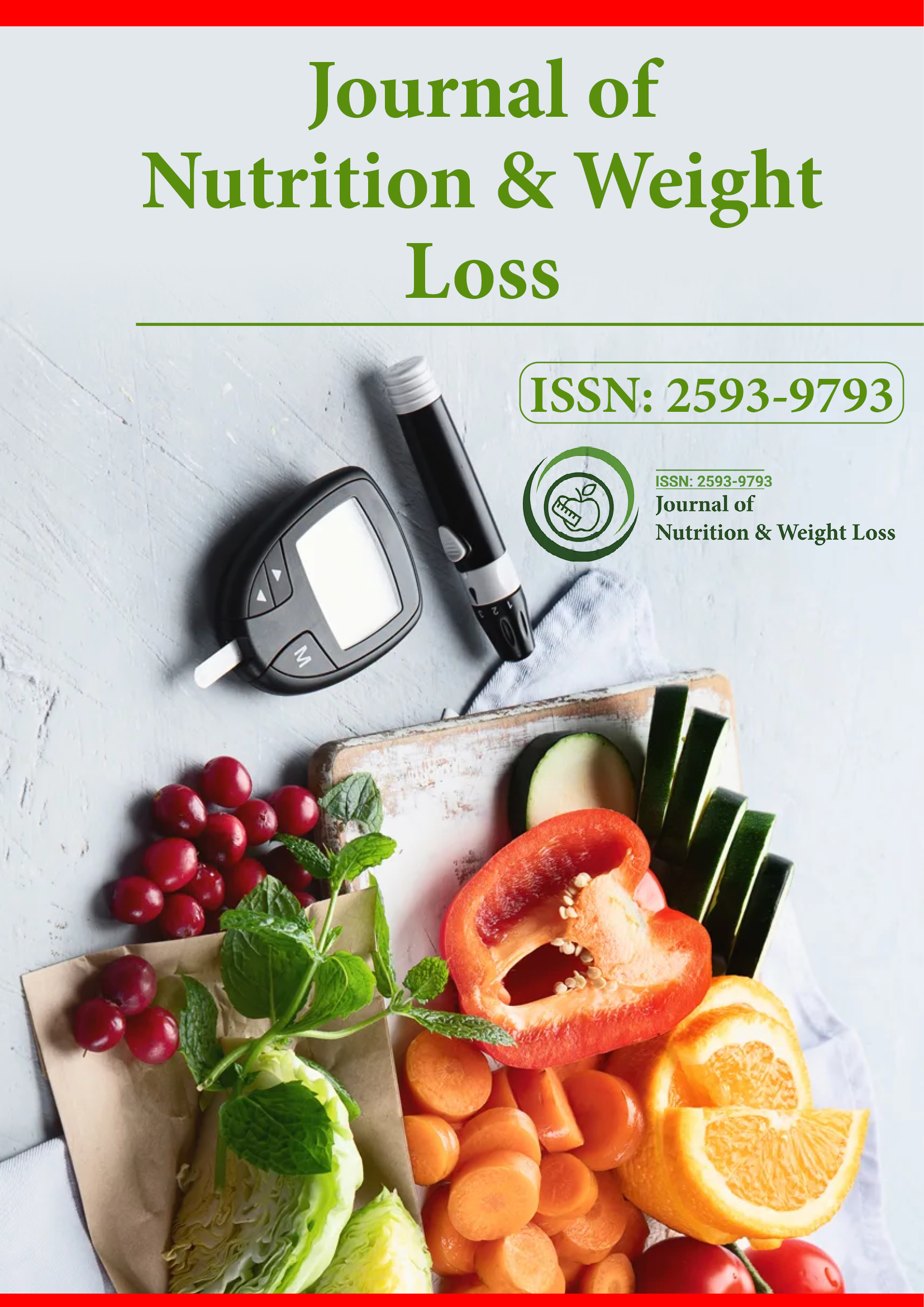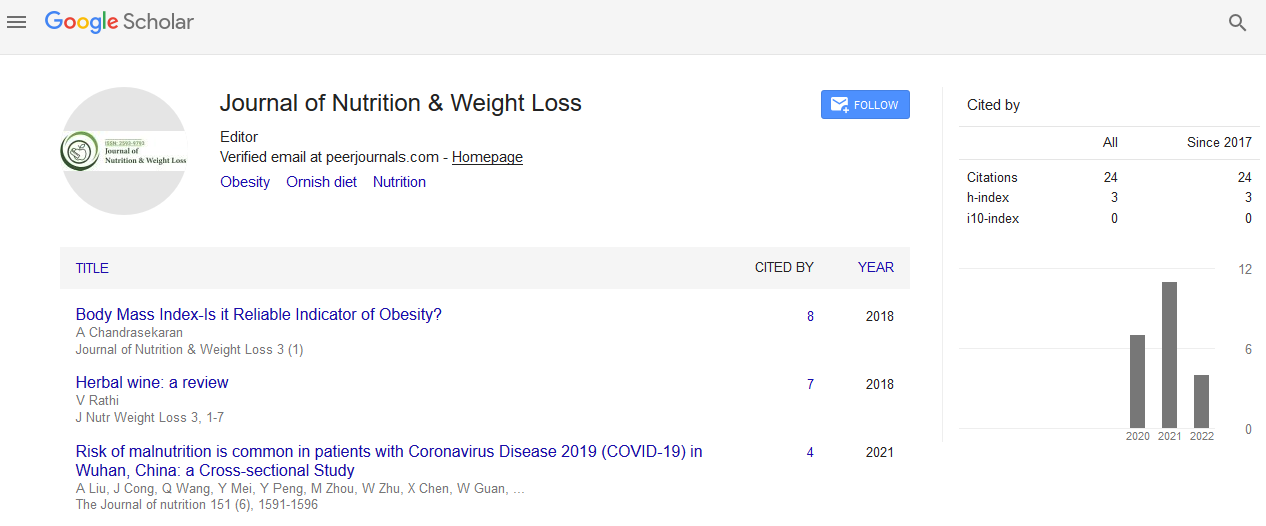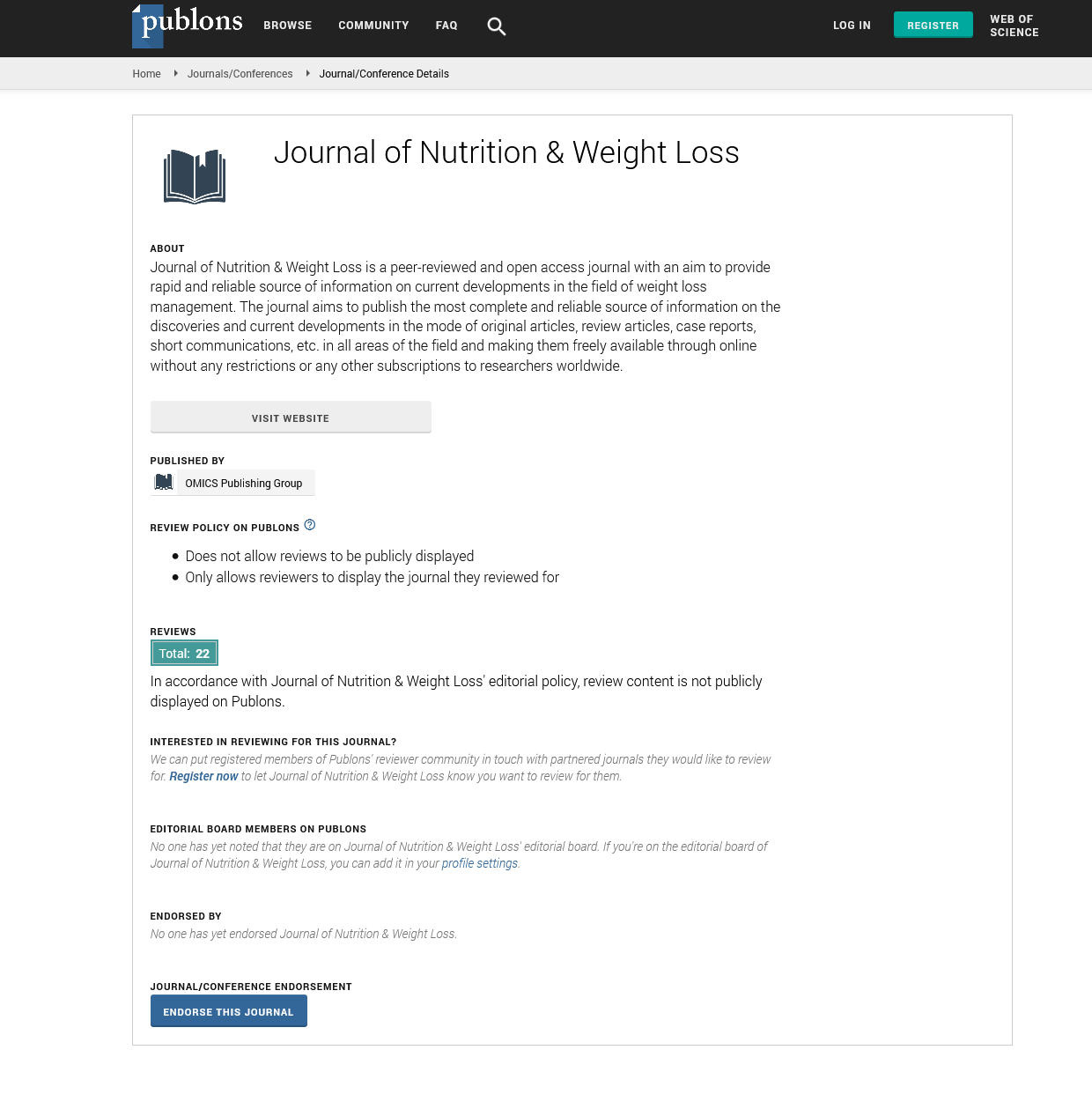Indexed In
- RefSeek
- Hamdard University
- EBSCO A-Z
- Publons
- Euro Pub
- Google Scholar
Useful Links
Share This Page
Journal Flyer

Open Access Journals
- Agri and Aquaculture
- Biochemistry
- Bioinformatics & Systems Biology
- Business & Management
- Chemistry
- Clinical Sciences
- Engineering
- Food & Nutrition
- General Science
- Genetics & Molecular Biology
- Immunology & Microbiology
- Medical Sciences
- Neuroscience & Psychology
- Nursing & Health Care
- Pharmaceutical Sciences
Perspective - (2021) Volume 0, Issue 0
Risk of Malnutrition is Common in Patients with Coronavirus Disease, 2019
Harapriya Sahoo*Received: 20-Jul-2021 Published: 07-Aug-2021
Perspective
The coronavirus disease 2019 (COVID-19) has immediately spread across the world. Notwithstanding, the dietary status of COVID-19 patients has not yet been broadly inspected. The point of this investigation was to assess the nourishing status of COVID-19 patients and to distinguish factors autonomously connected with lack of healthy sustenance hazard.
In this single-focus, cross-sectional examination, we broke down information from 760 hospitalized COVID-19 patients between 29 January 2020 and 15 March 2020. In view of the Nutrition Risk Screening (NRS) 2002 score, we isolated patients into the ordinary nourishment bunch (NRS score <3) and the lack of healthy sustenance hazard bunch (NRS score ≥3). The relationship old enough, sex, indications, comorbidities, BMI, serum egg whites and prealbumin fixations, illness seriousness, exercises of day by day living (ADL) score, and clinical results with unhealthiness hazard were investigated. Multivariable strategic relapse examination was utilized to recognize free factors related with ailing health hazard.
The COVID illness 2019 (COVID-19) pandemic brought about by extreme intense respiratory condition COVID-2 (SARS-CoV-2) proceeds unabated, presenting genuine dangers to worldwide wellbeing. Albeit the illness principally influences the respiratory plot, it might likewise make critical harm other objective organs, including the liver, heart, and kidneys, which may prompt demise because of different organ disappointment. Patients with COVID-19 normally present with extreme aggravation, fever, and diminished food admission.
The diminished food admission in COVID-19 patients expands the danger of unhealthiness, impacts the personal satisfaction, and may prompt horrible clinical results. Notwithstanding, the clinical pertinence of the wholesome status of patients with COVID-19 and the predominance of unhealthiness stay obscure. A new crosssectional investigation in 182 older COVID-19 patients announced hunger [Mini Nutritional Assessment (MNA) score <17] in 52.7% of patients and unhealthiness hazard (MNA score 17–23.5) in 27.5% of patients. Nonetheless, the nourishing status of COVID-19 patients in various age bunches has not been broadly announced.
In the current examination, we reflectively assessed the wholesome status of hospitalized COVID-19 patients and distinguished the free factors related with ailing health hazard in patients contaminated with SARS-CoV-2.
Coronavirus analysis depended on the 6th release of the rules gave by China's National Health Commission. In particular, we utilized the accompanying demonstrative rules: 1) a past filled with epidemiological openness; 2) clinical manifestations, like fever (≥37.3°C), hack, weakness, dyspnea, muscle touchiness, cerebral pain, or loose bowels; 3) lab tests showing that the complete number of white platelets was ordinary (4.0–10.0 × 109/L) or diminished (<4.0 × 109 /L) and the lymphocyte check was diminished (<1.0 × 109/L); 4) chest registered tomography showing various inconsistent shadows, ground-glass shadows, penetration, or solidification changes; and 5) positive discovery of SARS-CoV-2 nucleic corrosive by qRT-PCR utilizing pharyngeal swab examples. On the off chance that a patient had a past filled with epidemiological openness, he/ she should meet the rule number 5 and any 2 of standards 2, 3, and 4. In the event that a patient didn't have a background marked by epidemiological openness, he/she should meet the entirety of the models 2, 3, 4, and 5.
Hospitalized COVID-19 patients matured >18 y old were remembered for the investigation. Patients with one of the accompanying conditions were barred from the examination: pregnancy, obnubilation, phonetic challenges, fragmented clinical records (e.g., move to some other medical clinic), deficient surveys, serious hepatic brokenness, and extreme renal brokenness.
Patient qualities, including age, sexual orientation, side effects, BMI, comorbidities, infection seriousness, and clinical results, were separated from the medical clinic's electronic clinical records. Lab information, like serum egg whites and serum prealbumin focuses, were gathered from the emergency clinic's lab data framework; research center assessments were performed utilizing an Olympus AU-5400 programmed analyzer (Olympus).
Unhealthiness hazard was characterized as a NRS score of ≥3. Coronavirus cases were named gentle, moderate, extreme, or basic cases as per the clinical course. Grown-up gentle cases were viewed as those with clinical indications yet without strange aspiratory imaging discoveries; moderate cases were viewed as those with both clinical manifestations and unusual pneumonic imaging discoveries.
Extreme cases were viewed as those with any of the accompanying models: 1) respiratory pain (≥30 breaths/min), 2) resting oxygen immersion ≤93%, or 3) blood vessel incomplete pressing factor of oxygen (PaO2 )/part of roused oxygen (FiO2 ) ≤300 mm Hg (1 mm Hg = 0.133 kPa). Basic cases were characterized as those with respiratory disappointment requiring mechanical ventilation or with other organ disappointment requiring emergency unit. Patient endurance was the essential clinical result evaluated.
Of patients with COVID-19, 82.6% were in danger of lack of healthy sustenance. There were factual contrasts in the age, occurrence of fever, BMI, serum egg whites and prealbumin focuses, ADL score, and sickness seriousness between the 2 gatherings. Multivariable strategic relapse investigation uncovered that age ≥65 y (versus <65 y; OR: 5.40; P < 0.001), serum egg whites <35 g/L (versus ≥35 g/L; OR: 3.61; P < 0.001), serum prealbumin <150 mg/L (versus ≥150 mg/L; OR: 2.88; P = 0.042), basic cases (versus moderate cases; OR: 4.46; P < 0.001), ADL score 41–60 (versus ADL score 100; OR: 4.50; P = 0.012), and ADL score ≤40 (versus ADL score 100; OR: 9.49; P < 0.001) were altogether connected with the danger of unhealthiness in COVID-19 patients.
This investigation showed that predominance of hunger hazard was high in COVID-19 patients. More seasoned age, low serum egg whites and prealbumin focuses, ADL score <60, and illness seriousness were free factors related with ailing health hazard.
Citation: Sahoo H (2021) Risk of Malnutrition is Common in Patients with Coronavirus Disease, 2019. J Nutr Weight Loss. 6:135
Copyright: © 2021 Sahoo H, This is an open-access article distributed under the terms of the Creative Commons Attribution License, which permits unrestricted use, distribution, and reproduction in any medium, provided the original author and source are credited.


